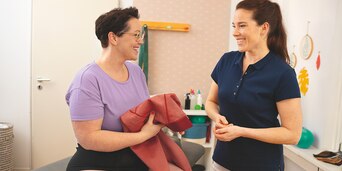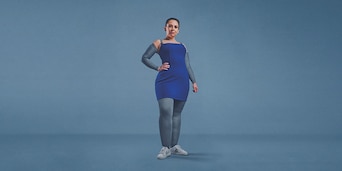Painful limbs are typical symptoms of lipedema, which can make it hard to stay active and manage a healthy weight, especially for individuals who are overweight. This, in turn, can result in a loss of muscle strength. However, exercise or being active in general positively influences your body and mind and can also improve your lipedema symptoms. In combination with balanced nutrition, exercise helps you to maintain a healthy weight. By contrast, most popular diets should be avoided as they focus on short-term effects but ultimately fail, leading to even more weight gain over time.

Increase your activity step by step
“Graded activity” is part of the holistic treatment of lipedema. It combines exercise with psychological support. The goal is to increase your activity step by step with a personalized plan. Initially, exercise may be accompanied by pain. But in the long-term, regular exercise improves your lipedema symptoms.
How exercise improves your lipedema symptoms
The reason why lipedema causes pain is not entirely understood. Experts explain that inflammation within your fatty tissue is the most likely reason for your pain. Regular exercise reduces inflammation, increases your blood flow, and supplies your body with oxygen. Being active is also beneficial for your emotional well-being, acting as a natural antidepressant.
What kind of exercise works best?
Your Healthcare Professional can help you to create an exercise plan. Lipedema exercise programs include a mixture of building muscle strength and aerobic exercises.
Good examples of aerobic exercises are yoga, pilates, nordic walking, cycling, or aquatic exercise. Swimming or water aerobics reduces the strain on your joints and muscles and also improves lymphatic flow. Yoga and Pilates are perfect for improving your flexibility.
Another part of your lipedema exercise program should focus on building muscle strength. You can start to implement resistance bands in your training that can gradually increase your strength. After a while, you can also use weights, but you should only increase the impact step by step.
Need some motivation?
Here are a few tips on how you can motivate yourself:
- Set realistic goals and increase your activity step by step.
- Make a plan – schedule your exercise at the beginning of each week and stick to it.
- Share your plan with your family and friends.
- If possible, exercise together with a friend.
- Listen to music that motivates you when you exercise.
- Change activities when you don’t like them. If it is not swimming, maybe Nordic walking or yoga works for you.
- Look back at what you have achieved at the end of each week and think of new goals for the upcoming week.
- Treat yourself – enjoy a massage or facial mask as a reward.
Besides exercise, balanced nutrition is another key element of a healthy lifestyle.


